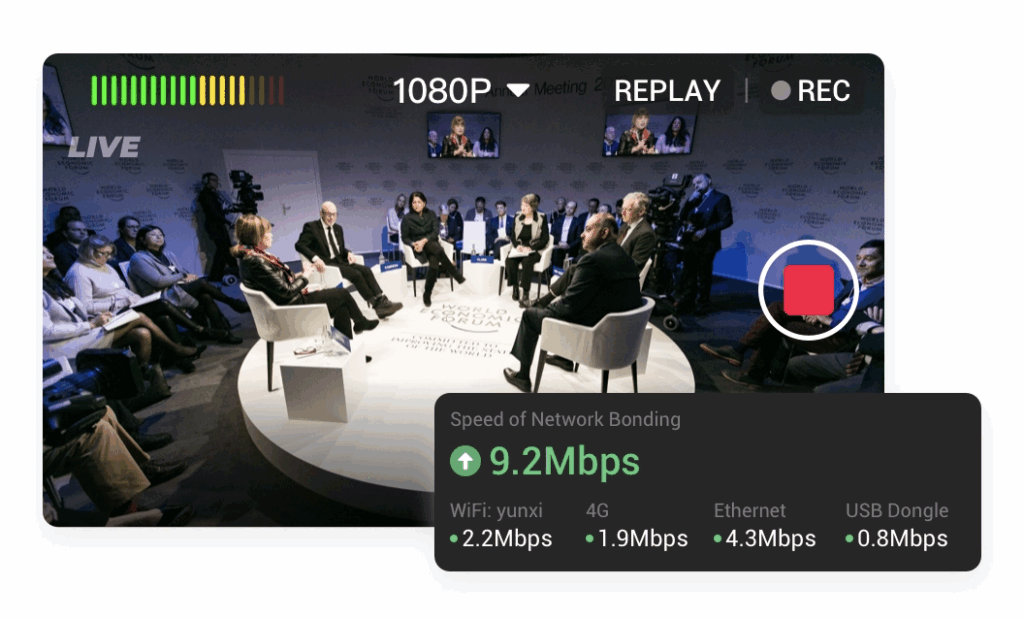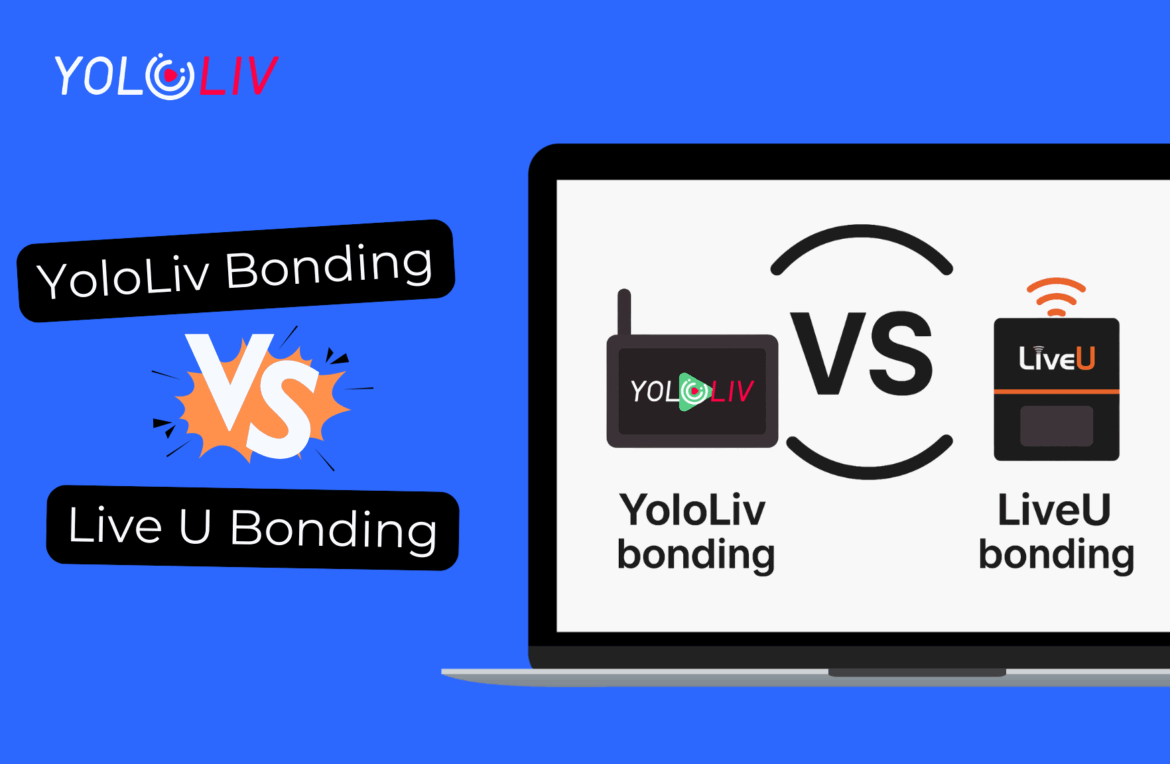Live streaming is now a key tool for creators, event hosts, and businesses. A good live stream needs clear video, good sound, and most of all, a strong and stable internet connection. But in real life, networks can be slow or drop without warning. This is a big problem when you stream from outdoor events, busy public spaces, or places with poor WiFi.
To solve this, many streamers use a method called network bonding. It mixes two or more internet connections into one stronger link. This helps stop buffering and keeps the stream running.
For years, LiveU has been a big name in this area. Many people know it for strong and stable streaming tools. But LiveU gear can be costly and harder to set up for new users. YoloLiv now offers another way. Its network bonding feature is built inside the YoloBox live streaming device. It is easier to use and has more flexible prices.
This post will explain what network bonding is, how YoloLiv network bonding works, how it compares with LiveU, and why it may be the best choice for many streamers today.
What is Network Bonding
Network bonding is a technology that combines multiple internet connections to create a more stable, faster, and reliable connection for data transmission, especially for live streaming. It comes in different forms depending on the type of networks being bonded. Common classifications include IP bonding, which aggregates general internet connections, and cellular bonding, which focuses on combining multiple mobile networks like 4G or 5G. These classifications all share the same goal: to enhance streaming stability, reduce interruptions, and improve overall bandwidth by intelligently managing multiple connections.
Within network bonding, there are two main operational modes:
Aggregation (Bonding):
This mode splits data packets across all available connections and recombines them at the receiving end. By combining the bandwidth of multiple networks, aggregation ensures smoother streaming and higher data throughput, reducing lag and buffering.
Example:
Imagine you are streaming live with a 5G connection as the primary network and LTE as the backup. If the 5G signal suddenly drops or becomes too weak to support the stream, the device automatically switches to LTE. The live stream continues without interruption, although total bandwidth doesn’t increase, and video quality may slightly drop.
Failover (Transfer/Backup):
In this mode, one connection serves as the primary channel, while others act as backups. If the primary network experiences interruptions, the system automatically switches to a backup connection, maintaining a continuous stream without noticeable downtime.
Example:
If you have a 3 Mbps SIM card, a 7 Mbps Wi-Fi connection, and a 5 Mbps Ethernet connection, aggregation allows you to achieve a total bandwidth of 15 Mbps for reliable streaming. Additionally, if one connection temporarily fails, the others can compensate for the performance drop.
What is YoloLiv Network Bonding?
YoloLiv Network Bonding is a built-in feature in YoloBox devices that bonds multiple internet connections: Wi-Fi, Ethernet, and SIM card, and USB dongles into 1 to ensure stable and reliable live streaming.

How YoloLiv’s Network Bonding Works
YoloLiv Network Bonding combines multiple internet channels into a single, stable connection. These channels can include Wi-Fi, LAN, SIM cards (4G), and other internet sources, all integrated directly into the YoloBox device.
Once connected, YoloLiv’s backend system uses the QUIC protocol (UDP-based) to transmit video and audio to the cloud efficiently. YoloLiv’s servers are distributed worldwide, ensuring low-latency streaming. Once the data reaches the cloud, it is converted into standard formats like RTMP or SRT and then broadcasted to platforms such as Facebook, YouTube, or any other desired video distribution service.
This approach ensures that live streams remain stable and high-quality even if individual network channels fluctuate, while giving users a simple, plug-and-play experience.
Differences between YoloLiv Bonding and LiveU Bonding
Technically:
| Feature | YoloLiv Network Bonding | LiveU LRT |
|---|---|---|
| Core Protocol | Proprietary t-quic protocol, supporting TCP & UDP aggregated transmission | LRT™ (LiveU Reliable Transport), proprietary UDP-based protocol |
| Reliability Mechanism | Combines FEC + ARQ: FEC handles burst packet loss, ARQ handles targeted retransmissions; integrates neural-network-based bandwidth prediction for dynamic bandwidth allocation and encoding bitrate | Dynamic FEC + streaming ARQ, adjusts redundancy based on real-time network quality; no public description of AI-based bandwidth prediction |
| Latency & Switching | Native QUIC 0-RTT handshake, connection migration, multiplexing; in-band link probing allows switching within ≤1 RTT | LRT detects link degradation within seconds and switches, emphasizes end-to-end latency control |
| Protocol Adaptation & Optimization | Deeply optimized for RTMP / SRT / RTC, especially RTC for out-of-order packet reassembly, bandwidth stability, and low latency performance | Primarily optimized for long-duration video streaming (H.264/H.265); protocol stack adapts to multiple streaming methods, but core relies on LRT |
Why YoloLiv Network Bonding Stands Out
Technical Advantages
Future-Proof with AI: YoloLiv is among the first to bring AI-powered bandwidth prediction into network bonding. This cutting-edge feature intelligently allocates bandwidth in real time, ensuring smoother and smarter live streaming. Unlike traditional bonding methods that rely on rigid strategies, AI prediction makes streaming more adaptive, reliable, and ready for the future of online broadcasting.
Flexibility for Creators: Unlike LiveU’s one-size-fits-all approach, YoloLiv puts control back into the hands of creators. You can customize settings based on cost, performance, and network priorities. Whether you’re an independent content creator, a church running weekly services, a school hosting online classes, or a business managing corporate streams, YoloLiv offers the flexibility to match your unique needs.
Optimized for Modern Streaming: Today’s audiences expect more than just stability—they want real-time interaction and low latency. YoloLiv’s bonding technology is built to meet these demands, delivering smooth performance for online events, live gaming, hybrid classrooms, and other interactive streaming environments. This makes it an ideal solution for creators who need both quality and immediacy in their broadcasts.
Other Benefits
Seamless and Reliable Setup: YoloLiv Network Bonding is deeply integrated into YoloBox. Unlike other solutions that require external hardware or complex configuration, YoloLiv’s multi-network aggregation software is built into the device system, ensuring high stability. This deep system-level integration prevents crashes and other operational issues, giving broadcasters a reliable, plug-and-play experience.
Cost-Effective Plans: While LiveU only offers limited subscription options ($45/month or $450/year), YoloLiv provides flexible plans tailored to different streaming needs. Whether you are a casual content creator or a professional broadcaster, you can select a plan that balances cost and performance, making professional network bonding more accessible.

Global Coverage and Device Integration: YoloLiv’s worldwide server network ensures low latency and consistent streaming quality. Combined with full integration in YoloBox, users can manage multi-platform streaming, cloud recording, and overlays from a single, easy-to-use device, simplifying workflow and saving time.
Conclusion
Network bonding has become a crucial tool for content creators and broadcasters who need stable, high-quality live streaming across multiple platforms. By combining multiple internet connections—whether WiFi, Ethernet, LTE, or USB modems—bonding ensures uninterrupted streams, higher bandwidth, and better overall performance.
YoloLiv Network Bonding, built directly into YoloBox, offers a seamless, cost-effective, and reliable solution. With deep system integration, proprietary algorithms optimized for mobile networks, UDP acceleration, and support for multiple streaming protocols like SRT and RTMP, YoloLiv ensures smooth, high-quality live broadcasts even in challenging network environments. Flexible subscription plans, worldwide server coverage, and full device integration further enhance its appeal.
Compared to traditional solutions like LiveU, YoloLiv provides a more accessible, user-friendly, and technically robust alternative, making professional-grade network bonding available to a wider range of creators.
Click to subscribe to the YoloLiv network bonding and find the best plan: https://www.yololiv.com/network-bonding
19,974 total views, 131 views today

Hailey, a Customer Success Specialist at Yololiv, she brings immense enthusiasm to assisting users in understanding the various features of YoloCast and resolving any usage-related issues they may encounter. Alongside her support efforts, she also curates articles sharing tips, troubleshooting advice, and other helpful insights to enhance users’ experience with YoloCast.


